#Python task queue
Explore tagged Tumblr posts
Text
Django and Celery for Asynchronous Tasks
Introduction Asynchronous tasks are crucial for performing time-consuming operations, such as sending emails, processing images, or executing background jobs, without blocking the main application flow. Celery is a powerful, production-ready task queue system that integrates seamlessly with Django. This guide will walk you through setting up Celery in a Django project, configuring it to handle…
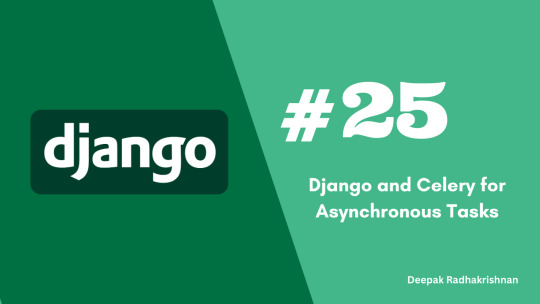
View On WordPress
#Asynchronous tasks#Celery with Django#Django background jobs#Django Celery#Django Tutorial#Python task queue
0 notes
Text


I work better at day, but study way better at night. This week I was made a deeply study using Lua Programming Language with LUAMQ to find a way to attach too many files in a MQ Queue. This means learn a lot of ways of how and the properly way to use Lua functions work with as bash/shell scripts, understand permissions and everything. Normally, there is a good tool to made things changes like that, like Ansible, but in some cases, it is not flexible enough. And I assume that could have been done with Python and a MQ library for py, but I don´t even bother myself to search for it. Lua was my first thought and for a simple task like that, it fits.
#study aesthetic#studyblog#study community#study art#study space#study motivation#student life#student blog#student university#studies and work.#study study study#studyblr#studyblr comm#developer#programming#software development#software#software engineering#software engineer#studyblr brazil#studyblr portugal#study portugal#programmer#coding#study room#study blog#studying aesthetic#studying inspiration
21 notes
·
View notes
Text

👀 honestly that is a really nice description of it however I realized something else.
I would probably like grasses and prairies a lot more but. As someone who lives in Florida whos mom is scared of snakes who is slowly trying to be Less Paranoid about Snakes but is also Still Kinda Scared Of Snakes
I see a bunch of tall grass and my brain goes ‘oh thats snake land’
But 👀 the grass lovers are so incredibly valid and valued I love yalls love for grasses.
Cringe gardening confession that becomes more evident the longer I read this book: I just can’t find it in me to give that much of a shit about trees.
#out of queue#ani rambles#‘but Ani you get snakes sometimes in your flower garden or even just in your lawn’ yes thats true#but let me tell you at least everyone in my family circles goes#‘tall grass? SNAKES. big expanse of wildflowers? SNAKES.’#like even if I’m not already thinking it they are saying it#and snakes are a valid part of the ecosystem and I’m not ‘oh thats a snake go kill it’ like my mom is#but also. snakes be kinda spooky#i got jumpscared by a snake a week or 2 back actually#fortunately all of the times I’ve been jumpscared by a snake its just been a little black racer scooting around#but still.#i do like ball pythons though if I wasn’t squeamish at the idea of using feeder mice or keeping mice in the freezer I’d consider getting one#it would have to be after I move out though because. as I’ve explained before. my mom is terrified of snakes#one of her funniest stories she tells is about how one time she was turning on the sprinklers in the front yard#saw a snake skin thought it was a snake started running#but like at the exact speed that the sprinkler was going#(yknow the sprinklers with the little arm that goes KSH KSH KSH KSH across the yard and the KSHCHACHACHACHA on the way back? yeah those#and so every step she took she was just getting BLASTED in the back with the sprinklers#and she got back in the house absolutely SOPPING wet#anyways uh task 35 to becoming Good Native Habitat Person: Dont Be As Scared Of Snakes
34 notes
·
View notes
Text
QUEENS FANCLAN LORE: MIRE’LOK (marshland Na'vi)
Please do not steal my lore
Please ask to use any ideas from my lore or to make Ocs of my fanclans.
Minors & Ageless accounts do not interact with my pages.

Origins:
Were descendants of the Rivonyk who traveled more inland streamed finding a humid jungle and continued onward until the jungle opened up to healthy lushful marshlands. There they adapted to blend into the marshlands and jungle becoming their own people, which became the Mire’lok. They formed many tribes within the marshlands and jungle making both their vast home.
Physical Traits:
-Elong limbs such as arms and legs, tail and queues, they become more thin like, having more muscle build than fat.
-There's tails being meaty at the base and sliding down to a narrow tip with a fin-like structure at the end.
- skin tones changing to deeper hues of greens, teals and on rare occasions having morphs of bright greens and blues.
-Patterns becoming more snake-like patterns, specifically python and constrictor base like patterns.
- Eyes have variant pupils, they can have slit eye pupils or they can have round eye pupils.
Eye color can be bright greens, yellows with morphs having bright oranges and reds.
-Ears becoming smaller and closer to the head, with a protective skin flap that will cover their ear drums to keep water out of their ears.
-Noses being flat but with larger nostrils that help with the humid air.
Clan structure: Tribes
The Mire'lok are scattered throughout the jungle and marshland in tribes, each tribe having a leader or guardian and a consultant or Tsahik.
The tribes would be made up of 20-30 individuals where young adults would leave to survive the lands on their own before meeting up with others their age and forming newer tribe's.
The eldest of the groups would become the Guardian of the tribe and their mate being the tribes Tsahik.
Tribe Roles.
Guardian- The leader of the tribe, their soley responsibilities are to protect the tribe from dangers. Building relationships of other tribes to form trade or safe travel.
They may also be the first generation of the tribes parent, for they may mate with all members of the forming tribe and have children as a was to show promise to them having a strong need to protect the tribe and have best interest for the tribe, for many of the tribe members are raising his or hers children.
Consultant/ Tsahik- They are responsible for performing rituals and healing the sick. They are also responsible in tribe matters such as disputes,guidance and Spirituality.
Hunters/ gathers
-Hunters- They are individuals who go into the jungle to hunt animals and bring the tribe a diverse variety of meats to enjoy.
-Fishers- They are responsible to supply the tribe with bountiful fish, they fish with nets and spears.
Gatherers- They are a split group of individuals, Half of them will gather in the jungles finding vines, flora, bones and any other resource needed for the tribe.
Marshland gatherers will gather reeds, shells, scales, and other resources to bring to the tribe.
Tsahík Gathers- Are one or two individuals who take the honored task of only gathering for the Tsahík. They will bring the Tsahík flora used in medicinal and ritual use as well as bones, crystals and shells.
Cafters- There the builders, crafters and artisans of the tribe.
They will be responsible in making the hunting tools such as spears, and netting.
The comforts which are clothing, wrapping, blankets and baskets, pouches.
They are the ones who will build small boats or rafts for the tribes.
Teachers/ Mentors- They aid the tribe by helping parents raise and educate their children. They will also teach each child the Roles of the Tribe and will find which Role would the child perform until they leave the tribe, or if they stay in the tribe and continue that Role.
Learners& Mentees-
Learners are children who are too young to help in a role. They are focused on being children, playing and learning from their parents and teachers.
Mentees- Are children who are now aiding the tribe by taking a role in the tribe. They are dealt with patience and any hard accomplishment made should be celebrated.
Ceremonies & Rituals:
Ceremonies and rituals play a significant role in the lives of the Marshland Na'vi, reflecting their deep connection to the unique environment and its ecosystem. Here are some potential ceremonies and rituals they might have:
Naming Ceremony:
Description: A rite of passage for newborns, where the clan gathers to name the child.
Details:
- Location: Near a sacred tree or at a special marshland site.
- Rituals: Parents present the child to the clan, and the Tsahík or Olo'eyktan gives the child a name believed to be chosen by Eywa.
- Symbols: Use of bioluminescent plants and flowers to adorn the child.
The child would then be placed into a woven basket and floated among the tribe where all will place gifts and flora of protection for the small child as they sing chants and prayer so that the child will be safe from sickness.
. Harvest Festival:
Description: Celebrating the abundance of the marshlands, this festival is held during peak harvesting times.
Details:
- Location: In the heart of the marsh, where resources are plentiful.
- Rituals: Singing, dancing, and sharing food. Special thanks are given to Eywa for the bounty.
- Symbols: Decorations with harvested reeds, flowers, and bioluminescent plants.
. Mating Ritual:
Description: A ceremony where mates publicly declare their bond.
Details:
- Location: At a sacred water body or marsh clearing.
- Rituals: Exchange of woven garlands and a dance symbolizing their union. They might also submerge themselves in water to signify purity and unity.
- Symbols: Garlands made from marsh flora and scales and shells..
Mourning Ritual:
Description: Honoring the deceased and ensuring their spirit joins Eywa.
Details:
When one is dead they will build a small boat and place the dead inside and loved ones will fill it with final deaths.
- Rituals: Songs and chants to guide the spirit, offerings of personal belongings, and then pushed out of the marshlands down a stream that will merge into a mighty river so that their body may make its way to Pandora's Ocean where they will join ewyas arms and be found in all bodies of water.
- Symbols: Use of bioluminescent materials to light the way for the spirit, Others written with dyes on the boat by the Tsahik to protect the spirit from harmful ones.
. Renewal Ceremony:
Description: Celebrating the cyclical nature of life and the renewal of the marshes.
Dancing in the rain, taking showers under the first downpour and planting moss on their boats.
Details:
- Location: At the onset of the rainy season.
- Rituals: Cleansing rituals involving water, collective planting of new marsh flora, and dances that mimic the flow of water.
- Symbols: Water motifs and patterns, use of fresh marsh plants.
Healing Ritual:
Description: A ceremony for the sick or injured to seek Eywa’s healing.
Details:
- Location: At a designated healing pool or grove.
- Rituals: Use of marsh herbs and medicinal plants, chants, and the presence of healers and the Tsahík.
- Symbols: Healing totems and symbols of health and vitality.
These ceremonies and rituals not only strengthen the Marshland Na'vi's bond with their environment but also reinforce their cultural values and communal ties.
Courting:
Courting among the Marshland Na'vi is a deeply respectful and meaningful process, rich with tradition and symbolic gestures. It involves not just the two individuals, but also their families and the wider community. Here’s how the courting process might be structured:
Initial Interest:
1. Subtle Signals:
- Glances and Gestures: Courting often begins with subtle glances, smiles, and gestures, showing mutual interest without overt displays.
- Gifts from Nature: Small gifts such as beautifully woven baskets, intricately carved trinkets, or rare flowers from the marshlands can be given to show affection.
First Steps:
1. Seeking Approval:
- Family Involvement: Before the courtship progresses, it is customary for the interested individual to seek approval from their family. This demonstrates respect for family bonds and traditions.
- Elder Consultation: Often, the suitor will also seek the advice of village elders or the Tsahík to ensure that their intentions align with cultural practices and spiritual beliefs.
2. Invitation:
- Joint Activities: The suitor may invite the object of their affection to join them in communal activities, such as fishing, gathering, or participating in rituals, providing opportunities for bonding.
Courting Rituals:
1. Symbolic Acts:
- Braiding Hair: One traditional act of courtship might involve the suitor offering to braid the other's hair with specially selected beads and crystals, symbolizing their intention to weave their lives together.
- Firefly Dance: Another ritual could involve a dance during the evening when the marsh is aglow with bioluminescent fireflies, symbolizing the light they bring into each other's lives.
2. Shared Tasks:
- Building and Crafting: Working together on communal projects, such as building a shelter or crafting tools, showcases their ability to collaborate and support each other.
- Harvesting Together: Collecting food or medicinal plants together signifies a willingness to share responsibilities and provide for one another.
Deeper Connection:
1. Personal Stories:
- Storytelling Evenings: Sharing personal stories, dreams, and aspirations around a communal fire strengthens emotional bonds and allows both individuals to understand each other's values and life goals.
- Songcord Exchange: Creating and exchanging songcords that tell the stories of their lives and their relationship symbolizes their deepening connection.
2. Private Moments:
- Quiet Time in Nature: Spending quiet moments together in the serene parts of the marsh, away from the bustling village, allows for private conversations and deeper emotional connection.
- Spiritual Connection: Participating in meditative practices or seeking guidance from Eywa together enhances their spiritual bond.
Community Acknowledgment:
1. Public Declarations:
- Formal Announcement: Once both individuals feel ready, they make a formal announcement of their courtship to their families and the community, often during a communal gathering or ceremony.
- Blessing from the Tsahík: Receiving a blessing from the Tsahík signifies the community's acceptance and support of their relationship.
2. Celebration:
- Feast and Dance: The announcement is often followed by a feast and dance, celebrating the new bond and welcoming the couple's union into the community.
- Gift Exchange: Families and friends exchange gifts with the couple, symbolizing their support and blessing for the future.
Betrothal and Beyond:
1. Betrothal Ceremony:
- Promise Exchange: A formal betrothal ceremony where the couple exchanges promises and gifts that signify their commitment to each other.
- Community Support: The community gathers to witness and support the betrothal, reinforcing the societal bonds that will sustain the couple.
2. Preparation for Union:
- Building a Home: The couple, along with their families, may start preparing a home where they will live together after their union.
- Learning Roles: The couple spends time learning the specific roles and responsibilities they will take on as partners in life and within
Pre-Mating Rituals:
1. Deepening Bond:
- Tsahik’s Blessing: The couple seeks the blessing of the Tsahik, who provides guidance and ensures their union aligns with Eywa's will.
- Private Time in Nature: The couple spends significant time in nature, meditating and seeking a deeper connection with each other and Eywa.
2. Preparing the Community:
- Announcement of Intent: The couple announced their intent to mate permanently to their families and the community during a communal gathering.
- Community Support: Families and community members offer their blessings, advice, and support, preparing for the upcoming ceremony.
Mating Ceremony:
1. Location:
- Sacred Site: The ceremony takes place at a sacred site within the marshlands, often beneath a Tsawmakto (Mossy Marsh Tree) or near a bioluminescent pond.
- Decorations: The area is decorated with flowers, woven banners, and bioluminescent plants to create a magical and sacred atmosphere.
2. Ceremony:
- Tsahik’s Role: The Tsahik leads the ceremony, invoking Eywa and blessing the union. The Tsahik may also use bioluminescent water and sacred herbs to purify the couple.
- Vows Exchange: The couple exchanged vows, promising to support, love, and honor each other for life. They may also exchange symbolic gifts, such as intricately carved tokens or woven bands.
3. Tsaheylu (Bonding):
- Neural Connection: The couple performs Tsaheylu, the neural connection, by linking their queues (neural braids), symbolizing their deep emotional and spiritual bond.
- Communal Witnessing: The community witnesses this sacred moment, reinforcing the importance of their union within the tribe.
Post ceremony:
1. Feasting and Dancing:
- Communal Feast: The ceremony is followed by a communal feast, with abundant food and drink, celebrating the new union.
- Traditional Dances: Traditional dances are performed, with the couple joining in, symbolizing their integration into the community as a mated pair.
2. Gift Giving:
- Community Gifts: Community members present gifts to the couple, such as crafted items, tools, or materials for building their home.
- Couple’s Gratitude: The couple expresses their gratitude to the community, often through speeches or shared songs.
Life as a Mated Pair:
1. Establishing a Home:
- Building Together: The couple works together to build their home, often with help from family and friends, creating a space that reflects their bond.
- Shared Responsibilities: They share responsibilities in daily life, from gathering food to raising children, supporting each other in all aspects.
2. Continuing Growth:
- Ongoing Bonding: The couple continues to strengthen their bond through shared experiences, spiritual practices, and regular Tsaheylu.
- Elder Guidance: They seek guidance from elders and the Tsahik as they navigate challenges and grow together.
Raising a Family:
1. Children’s Blessing:
- Ceremonial Blessing: When children are born, they are blessed by the Tsahik, and their birth is celebrated by the community.
- Parental Roles: Both parents take active roles in raising and educating their children, teaching them the tribe's values, traditions, and survival skills.
2. Community Involvement:
- Shared Parenting: The community plays a significant role in child-rearing, ensuring that children grow up in a supportive and nurturing environment.
- Mentorship: Elders and experienced tribe members act as mentors, passing down knowledge and wisdom to the younger generation.
Spiritual Continuity:
1. Connection to Eywa:
- Spiritual Practices: The couple engages in regular spiritual practices, such as meditation and rituals, to maintain a strong connection to Eywa.
- Teaching Children: They teach their children the importance of Eywa and guide them in developing their own spiritual practices.
2. Legacy:
- Passing on Traditions: The couple ensures that their cultural heritage and traditions are passed down to future generations, maintaining the tribe's identity and values.
- Elders’ Role: As they age, they take on roles as elders, providing guidance and support to younger tribe members.
Significance of Mating:
1. Sacred Union:
- Lifelong Bond: Mating is seen as a lifelong bond that goes beyond the physical, encompassing emotional, spiritual, and communal aspects.
- Respect and Honor: The couple's union is respected and honored by the entire community, reinforcing the tribe's cohesion and values.
2. Cultural Continuity:
- Tradition Preservation: The mating process and associated rituals preserve and strengthen the tribe's cultural traditions and identity.
- Community Strength: The strong bonds formed through mating contribute to the overall strength and unity of the community.
Mating among the Marshland Na'vi is a deeply sacred and communal process that reinforces their values, spiritual beliefs, and social structure. It is a celebration of love, commitment, and the interconnectedness of all life.
Fashion:
Materials:
1. Natural Fibers:
- Aquatic Plant Fibers: Lightweight and water-resistant fibers from aquatic plants like reeds and water lilies are used for creating foot wrappings.
- Fish Skin and Scales: Fish skins are treated and used for additional durability and flexibility in foot wrappings.
2. Animal Products:
- Animal Skins: Skins from local animals, such as amphibians or smaller aquatic creatures, are used for their flexibility and strength.
Footwear:
1. Foot Wrappings:
- Design: Foot wrappings are made from natural, flexible materials like aquatic plant fibers or treated animal skins. They are designed to provide protection and support while being lightweight and water-resistant.
- Usage: These wrappings are primarily used during cooler weather or rough terrain. They are easily adjustable to fit various foot sizes and shapes, and can be quickly removed or adjusted as needed.
- Style: Wrappings are typically minimalist, often resembling wide bands or strips that are wrapped around the feet and secured with simple ties or fastenings.
Accessories:
1. Jewelry:
- Shell and Scale Jewelry: Necklaces, bracelets, and earrings made from shells, fish scales, and animal bones, often symbolizing achievements or clan affiliation.
- Waterproof Beads: Beads made from waterproof materials, woven into hair or worn as anklets and wristlets.
2. Hair Decorations:
- Sleek Styles: Hair is kept sleek and tied back or braided to reduce drag in the water, often adorned with waterproof beads and small charms.
- Waterproof Headdresses: For special occasions, headdresses made from woven reeds, feathers, and bioluminescent plants are worn.
Colors and Patterns:
1. Natural Palette:
- Earth and Water Tones: Clothing and accessories feature shades of green, blue, brown, and gray, reflecting the marshland environment.
- Natural Dyes: Colors are derived from local plants and minerals, providing a natural and sustainable palette.
2. Symbolic Patterns:
- Nature-Inspired Designs: Patterns mimic natural elements such as water ripples and textures of local flora and fauna, symbolizing their connection to the marshland environment.
Seasonal Variations:
1. Wet Season:
- Waterproof Layers: Extra layers made from treated plant fibers and animal skins provide protection from the rain and dampness.
- Hoods and Capes: Lightweight hoods and capes to protect from the rain while allowing easy movement.
2. Dry Season:
- Lightweight Fabrics: Minimalist, breathable fabrics keep the wearer cool and comfortable during the hotter, drier months.
- Sun Protection: Broad-brimmed hats made from reeds and light shawls protect against the sun's rays.
Function and Adaptability:
1. Practicality:
- Durable Construction: Clothing is designed to withstand the challenges of the marshland environment, including constant moisture, mud, and rough vegetation.
- Ease of Movement: Garments are tailored for swimming and maneuvering small boats, ensuring they do not hinder movement.
2. Adaptability:
- Multi-Use Items: Many clothing items serve multiple purposes, such as wraps that double as blankets or makeshift shelters.
- Adjustable Features: Clothing often includes adjustable ties and fastenings to accommodate changes in weather and activity levels.
Cultural Significance:
1. Identity and Status:
- Clan Affiliation: Clothing and accessories often indicate clan affiliation, with specific colors and patterns unique to each group.
- Social Status: The intricacy and quality of garments can signify social status, achievements, and roles within the tribe.
2. Spiritual Connection:
- Symbolic Elements: Many elements of fashion have spiritual significance, connecting the wearer to Eywa and the natural world.
- Ritual Importance: Special garments and accessories are reserved for rituals, enhancing their sacred nature and the wearer's role in the ceremony.
Animals:
Marshland Animals
1. Yilmar :
- Description: Large, amphibious creature with a streamlined body, covered in smooth, slippery scales. They have webbed feet and a long, prehensile tail used for balance and steering in water.
- Behavior: Primarily aquatic, but can move on land for short distances. They are carnivorous and feed on smaller fish and amphibians.
2. Lurri :
- Description: A large, wading bird with long, slender legs and a sharp, curved beak. They have vibrant plumage with colors that blend into the marshland vegetation.
- Behavior: They use their beak to forage for insects and small aquatic creatures in the mud and shallow water.
3. Wyl'kor :
- Description: A medium-sized, amphibious mammal with a sleek body covered in fur and scales. They have large, webbed feet and a long, flat tail.
- Behavior: Social creatures that live in family groups. They are excellent swimmers and are known for their playful behavior in the water.
4. Tsyr'nak :
- Description: A venomous, serpentine creature with a sleek, sinuous body covered in iridescent scales. They have a pair of retractable fangs and are highly agile.
- Behavior: Predatory and primarily nocturnal. They hunt small mammals, birds, and amphibians, using their venom to subdue prey.
5. Nyr’xil :
- Description: A sleek, reptilian predator with a long, agile body and sharp, retractable claws. Their scales are camouflaged to blend into the jungle undergrowth.
- Behavior: Highly stealthy and solitary. They use their camouflage and speed to ambush prey, often striking from a hidden position.
Jungle Animals
1. Xavok :
- Description: A large, arboreal predator resembling a cross between a jaguar and a panther. It has retractable claws and powerful limbs adapted for climbing.
- Behavior: Solitary and territorial, Xavok is an apex predator in the jungle, using stealth and speed to hunt larger prey.
2. Kyr'u :
- Description: A small, vibrant tree-dwelling mammal with a prehensile tail and large, expressive eyes. Their fur is often covered in bioluminescent patches.
- Behavior: Herbivorous and primarily nocturnal. They feed on fruits and leaves and use their bioluminescence to communicate and navigate the jungle canopy.
3. Rylat :
- Description: A massive, slow-moving herbivore with a thick, armored hide and long, curved tusks. They have a trunk-like appendage used to pull down branches.
- Behavior: Grazes on leaves and fruit. They travel in herds and use their tusks to fend off predators and clear paths through dense vegetation.
4. Vrahl :
- Description: A large, insectoid creature with a chitinous exoskeleton and multiple limbs. They have glowing, bioluminescent markings that change color based on their mood.
- Behavior: Social and highly organized, living in colonies. They are scavengers and use their bioluminescence to communicate and coordinate activities within their hive.
5. Nyr’xil :
- Description: A sleek, reptilian predator with a long, agile body and sharp, retractable claws. Their scales are camouflaged to blend into the jungle undergrowth.
- Behavior: Highly stealthy and solitary. They use their camouflage and speed to ambush prey, often striking from a hidden
Marshland Plants
1. Tsawkelun :
- Description: A large, water-loving plant with broad, heart-shaped leaves that float on the surface of the water. The leaves have a waxy coating to repel excess moisture.
- Uses: Provides shelter and food for various aquatic creatures. Its leaves and stems are used in traditional crafts and as natural water filters.
2. Myrniss :
- Description: A creeping vine with thick, fleshy leaves that are resistant to waterlogging. It produces small, fragrant flowers that bloom in clusters.
- Uses: The leaves can be used for medicinal purposes, and the flowers are used in rituals and as natural dyes.
3. Zyrek Root :
- Description: A sturdy, underground root with a bulbous shape. It has tough, fibrous skin and produces a sweet, starchy substance.
- Uses: Consumed as a food source and used in traditional medicine for its energizing properties.
4. Hyrla Fern :
- Description: A large fern with wide, feathery fronds that thrive in the wet, shady conditions of the marshland. It has a vibrant green color.
- Uses: Provides cover for small animals and is used in weaving mats and baskets.
5. Veshra Grass :
- Description: Tall, reed-like grass with flexible stems that bend with the wind. It has a thick root system that stabilizes the marshy soil.
- Uses: Used for construction of simple structures and for making strong, flexible ropes.
Jungle Plants
1. Lumetia Orchid :
- Description: A striking, bioluminescent orchid with large, glowing flowers that emit a soft light. It grows on the trunks of large trees and has a sweet fragrance.
- Uses: Its light helps guide creatures and Na'vi through the dense jungle at night. Flowers are used in ceremonial decorations.
2. Rilkor Vine :
- Description: A thick, woody vine with large, dark green leaves and small, edible berries. It has a strong, twisting growth pattern.
- Uses: The berries are a source of food, and the vine’s fibers are used for crafting and climbing.
3. Kylin Tree :
- Description: A massive, ancient tree with a wide canopy of broad, leathery leaves. It has a thick trunk covered in a rough, bark-like texture.
- Uses: Provides shelter and food for many jungle creatures. Its leaves and bark are used in traditional medicine and for making large canopies.
4. Syril Blossom :
- Description: A small, flowering plant with brightly colored petals that change hue based on the time of day. It has a strong, musky aroma.
- Uses: Used for attracting pollinators and as a natural insect repellent. Its petals are used in beauty and health rituals.
5. Talvir Fern :
- Description: A large, shade-tolerant fern with long, drooping fronds. It has a rich, emerald green color and thrives in the dense jungle understory.
- Uses: Provides ground cover and protection for smaller plants and animals. Its fronds are used in weaving and construction.
Spirit tree:
Tsawmakto (Mossy Marsh Tree)

Description:
The Tsawmakto is a majestic, moss-covered tree situated in the heart of the marshlands, often found on isolated, elevated patches of land known as marsh pads. Its presence creates a focal point in the landscape, providing essential ecological benefits and holding significant cultural value for the Marshland Na'vi.
Physical Characteristics:
1. Trunk:
- Height: Reaches up to 20 meters, making it a prominent landmark.
- Diameter: About 4-6 meters wide, giving it a solid and imposing appearance.
- Texture: Covered in thick layers of soft, spongy moss that hold moisture and support various small plants.
- Color: Dark brown with patches of vibrant green moss and bioluminescent lichen that glow faintly at night.
2. Roots:
- Structure: Extensive root system, some submerged in the water and others forming a network above ground.
- Marsh Pads: Roots elevate parts of the tree’s base, creating small, stable islands of dry ground in the marsh.
3. Leaves:
- Shape: Large, oval leaves with a slightly serrated edge, adapted to capture sunlight and shed water efficiently.
- Color: Deep green with a matte finish and subtle bioluminescent veins visible at night.
- Arrangement: Form a dense canopy that provides ample shade and habitat.
4. Branches:
- Structure: Thick, gnarled branches that spread wide, creating a sprawling crown.
- Epiphytes: Home to various epiphytes, including hanging moss, ferns, and bioluminescent flowers.
5. Flowers:
- Appearance: Small, delicate flowers that bloom in clusters along the branches.
- Color: Soft hues of blue and white with bioluminescent centers that attract nocturnal pollinators.
- Pollination: Primarily by insects and small nocturnal creatures.
6. Fruits:
- Appearance: Small, berry-like fruits that dangle from the branches.
- Color: Start green and mature to a deep purple.
- Use: Edible, with a mildly sweet flavor, consumed by both Na'vi and wildlife.
Ecological Role:
1. Habitat:
- Biodiversity: Provides a habitat for a wide range of species, including amphibians, insects, birds, and small mammals.
- Shelter: Its branches and mossy trunk offer protection and nesting sites.
2. Water Filtration:
- Roots: Help to filter and purify the surrounding water, maintaining the health of the marsh.
3. Soil Stabilization:
- Root System: Anchors the soil, preventing erosion and creating stable ground in the marshlands.
Cultural Significance:
1. Spiritual Connection:
- Sacred Tree: Considered sacred, often serving as a site for rituals and ceremonies.
- Symbol: Represents resilience, life, and the nurturing power of nature.
2. Practical Uses:
- Materials: Moss and bark used for crafting and building; roots harvested for tools and structures.
- Medicine: Various parts used in traditional remedies for their healing properties.
- Food: Fruits provide a nutritious source of sustenance.
Additional Features:
1. Bioluminescence:
- Purpose: Attracts pollinators and provides natural light in the marshlands at night.
- Aesthetics: Creates a beautiful, glowing centerpiece, particularly striking during the evening.
2. Symbiotic Relationships:
- Fauna: Hosts animals that aid in pollination and seed dispersal.
- Flora: Supports other plants that grow on or around it, fostering a diverse ecosystem.
The Tsawmakto, with its moss-covered trunk and bioluminescent features, stands as a beacon of life and balance in the marshlands. It serves not only as an ecological cornerstone but also as a cultural and spiritual hub for the Marshland Na'vi.
Impact of Meteor Strikes on the Marshlands and Jungle
Tragedy
The Mire'lok would experience a great Tragedy when meteorites came crashing down from the skies plaguing the Marshlands and Jungle with exploding meteorite's damaging and forever changing their homelands.
1. Jungle Transformation
Impact and Immediate Effects:
- Meteor Strikes: Upon impact, the meteorites caused massive fires and shockwaves, decimating the dense jungle. The initial explosions uprooted trees, shattered the canopy, and sent ash and debris into the air.
- Destruction: The high temperatures from the impacts ignited widespread fires that burned through the rich vegetation and forest floor, turning vibrant, green jungles into a wasteland of charred trees and smoldering ruins.
Long-Term Changes:
- Dead Forest: Over time, the once-lush jungle transformed into a bleak, dead forest. The surviving trees, scorched and stripped of their foliage, stood as stark, skeletal remnants. These trees became brittle and eventually fell, their remains turning into a crumbling layer of ash and decay.
- Ash and Dust: The intense fires and the subsequent erosion spread ash and soot across the land. The soil, once rich in nutrients, became a dry, ashen layer. The frequent winds carried fine particles across the landscape, creating vast fields of dust and forming a barren, sandy terrain.
- Ecological Collapse: The loss of flora led to the collapse of the jungle’s complex ecosystem. Without plant life to sustain them, many animal species perished, and the once vibrant jungle turned into a desolate, sandy wasteland, characterized by the skeletal remains of trees and patches of ash.
2. Marshland Transformation
Impact and Immediate Effects:
- Meteor Strikes: The meteorites impacted the marshlands with similar devastation, creating large craters and causing violent shockwaves. The initial impacts flooded the marshlands with molten rock and debris, killing many aquatic and semi-aquatic species.
- Contamination: The meteorites released toxic substances into the environment, contaminating the water and soil. The once-pristine waters of the marshlands became polluted with harmful chemicals and heavy metals.
Long-Term Changes:
- Desiccation: The impacts and subsequent contamination led to the drying up of the marshlands. The once-waterlogged terrain, rich with plant and animal life, turned into expansive fields of dust and ash. The remaining water sources evaporated or were tainted beyond recovery.
- Formation of Desert: Over time, the marshland transitioned into a vast, sandy desert. The once-moist, fertile grounds became arid, with persistent dust storms reshaping the landscape. The marshes' iconic reeds and water plants were replaced by barren stretches of sand and scattered ash.
- Ecological Collapse: The extinction of many marshland species left the ecosystem in ruins. The terrain became inhospitable, and the environmental changes contributed to the formation of a desert landscape with minimal remaining life.
3. Mirelok Distinctions
Division and Migration:
- Travel to Dusty Lands: Some Mirelok, adapted to the harsh, dry conditions, migrated towards the newly formed sandy desert. These Mirelok had to evolve to survive in the arid environment, developing traits to cope with the extreme heat and lack of water.
- Adaptation to Deserts: The Mirelok in these regions adapted to the vast, dusty expanses, learning to find scarce resources and shelter amidst the sand. They became resilient to the harsh, desolate conditions of their new home.
Movement to Contaminated Bogs:
Other Mirelok sought refuge in the remaining bogs and swamps, which were heavily contaminated by the meteor strikes. These Mirelok adapted to the polluted environments, developing resistance to toxins and evolving to survive in the toxic, unstable conditions.
Adaptation and Survival:
- toxic Adaptations: Mirelok in the contaminated bogs evolved to handle the toxic substances in the water and soil. They developed specialized mechanisms to filter toxins and adapt to the altered chemical makeup of their habitat.

- Desert Adaptations: Mirelok in the desert evolved traits suited for survival in the arid, sandy landscape. They became adept at finding food and water in the harsh conditions, using their adaptations to thrive despite the challenging environment.

In summary, the meteor impacts caused catastrophic changes to both the jungle and marshlands. The jungle turned into a dead forest of withered trees and ash, while the marshlands became a vast desert of dust and sand. The Mirelok adapted to their new environments, with some finding refuge in the desert and others enduring the toxic bogs.
Evolution chains-
Starts of the Barren Land ancestors
&
Parluna'vi.
_________
PLEASE DO NOT STEAL MY LORE
PLEASE ASK TO USE MY IDEAS OR MAKE OCS TO MY FANCLANS
MINORS & AGELESS ACCOUNTS DO NOT INTERACT WITH MY PAGES!
#avatar way of water fanfics#avatar way of water#james cameron avatar#avatar#18+ fanfic#na'vi oc#avatar2#fanclan#naviocspecies#avatar oc#Na'vi fanclan species#na'vi fanclans#Na'vi fanclan#Fanclan lore#Fanclan species lore#Do not steal#my lore
6 notes
·
View notes
Text
Mastering Data Structures: A Comprehensive Course for Beginners
Data structures are one of the foundational concepts in computer science and software development. Mastering data structures is essential for anyone looking to pursue a career in programming, software engineering, or computer science. This article will explore the importance of a Data Structure Course, what it covers, and how it can help you excel in coding challenges and interviews.
1. What Is a Data Structure Course?
A Data Structure Course teaches students about the various ways data can be organized, stored, and manipulated efficiently. These structures are crucial for solving complex problems and optimizing the performance of applications. The course generally covers theoretical concepts along with practical applications using programming languages like C++, Java, or Python.
By the end of the course, students will gain proficiency in selecting the right data structure for different problem types, improving their problem-solving abilities.
2. Why Take a Data Structure Course?
Learning data structures is vital for both beginners and experienced developers. Here are some key reasons to enroll in a Data Structure Course:
a) Essential for Coding Interviews
Companies like Google, Amazon, and Facebook focus heavily on data structures in their coding interviews. A solid understanding of data structures is essential to pass these interviews successfully. Employers assess your problem-solving skills, and your knowledge of data structures can set you apart from other candidates.
b) Improves Problem-Solving Skills
With the right data structure knowledge, you can solve real-world problems more efficiently. A well-designed data structure leads to faster algorithms, which is critical when handling large datasets or working on performance-sensitive applications.
c) Boosts Programming Competency
A good grasp of data structures makes coding more intuitive. Whether you are developing an app, building a website, or working on software tools, understanding how to work with different data structures will help you write clean and efficient code.
3. Key Topics Covered in a Data Structure Course
A Data Structure Course typically spans a range of topics designed to teach students how to use and implement different structures. Below are some key topics you will encounter:
a) Arrays and Linked Lists
Arrays are one of the most basic data structures. A Data Structure Course will teach you how to use arrays for storing and accessing data in contiguous memory locations. Linked lists, on the other hand, involve nodes that hold data and pointers to the next node. Students will learn the differences, advantages, and disadvantages of both structures.
b) Stacks and Queues
Stacks and queues are fundamental data structures used to store and retrieve data in a specific order. A Data Structure Course will cover the LIFO (Last In, First Out) principle for stacks and FIFO (First In, First Out) for queues, explaining their use in various algorithms and applications like web browsers and task scheduling.
c) Trees and Graphs
Trees and graphs are hierarchical structures used in organizing data. A Data Structure Course teaches how trees, such as binary trees, binary search trees (BST), and AVL trees, are used in organizing hierarchical data. Graphs are important for representing relationships between entities, such as in social networks, and are used in algorithms like Dijkstra's and BFS/DFS.
d) Hashing
Hashing is a technique used to convert a given key into an index in an array. A Data Structure Course will cover hash tables, hash maps, and collision resolution techniques, which are crucial for fast data retrieval and manipulation.
e) Sorting and Searching Algorithms
Sorting and searching are essential operations for working with data. A Data Structure Course provides a detailed study of algorithms like quicksort, merge sort, and binary search. Understanding these algorithms and how they interact with data structures can help you optimize solutions to various problems.
4. Practical Benefits of Enrolling in a Data Structure Course
a) Hands-on Experience
A Data Structure Course typically includes plenty of coding exercises, allowing students to implement data structures and algorithms from scratch. This hands-on experience is invaluable when applying concepts to real-world problems.
b) Critical Thinking and Efficiency
Data structures are all about optimizing efficiency. By learning the most effective ways to store and manipulate data, students improve their critical thinking skills, which are essential in programming. Selecting the right data structure for a problem can drastically reduce time and space complexity.
c) Better Understanding of Memory Management
Understanding how data is stored and accessed in memory is crucial for writing efficient code. A Data Structure Course will help you gain insights into memory management, pointers, and references, which are important concepts, especially in languages like C and C++.
5. Best Programming Languages for Data Structure Courses
While many programming languages can be used to teach data structures, some are particularly well-suited due to their memory management capabilities and ease of implementation. Some popular programming languages used in Data Structure Courses include:
C++: Offers low-level memory management and is perfect for teaching data structures.
Java: Widely used for teaching object-oriented principles and offers a rich set of libraries for implementing data structures.
Python: Known for its simplicity and ease of use, Python is great for beginners, though it may not offer the same level of control over memory as C++.
6. How to Choose the Right Data Structure Course?
Selecting the right Data Structure Course depends on several factors such as your learning goals, background, and preferred learning style. Consider the following when choosing:
a) Course Content and Curriculum
Make sure the course covers the topics you are interested in and aligns with your learning objectives. A comprehensive Data Structure Course should provide a balance between theory and practical coding exercises.
b) Instructor Expertise
Look for courses taught by experienced instructors who have a solid background in computer science and software development.
c) Course Reviews and Ratings
Reviews and ratings from other students can provide valuable insights into the course’s quality and how well it prepares you for real-world applications.
7. Conclusion: Unlock Your Coding Potential with a Data Structure Course
In conclusion, a Data Structure Course is an essential investment for anyone serious about pursuing a career in software development or computer science. It equips you with the tools and skills to optimize your code, solve problems more efficiently, and excel in technical interviews. Whether you're a beginner or looking to strengthen your existing knowledge, a well-structured course can help you unlock your full coding potential.
By mastering data structures, you are not only preparing for interviews but also becoming a better programmer who can tackle complex challenges with ease.
3 notes
·
View notes
Text
What is Data Structure in Python?
Summary: Explore what data structure in Python is, including built-in types like lists, tuples, dictionaries, and sets, as well as advanced structures such as queues and trees. Understanding these can optimize performance and data handling.

Introduction
Data structures are fundamental in programming, organizing and managing data efficiently for optimal performance. Understanding "What is data structure in Python" is crucial for developers to write effective and efficient code. Python, a versatile language, offers a range of built-in and advanced data structures that cater to various needs.
This blog aims to explore the different data structures available in Python, their uses, and how to choose the right one for your tasks. By delving into Python’s data structures, you'll enhance your ability to handle data and solve complex problems effectively.
What are Data Structures?
Data structures are organizational frameworks that enable programmers to store, manage, and retrieve data efficiently. They define the way data is arranged in memory and dictate the operations that can be performed on that data. In essence, data structures are the building blocks of programming that allow you to handle data systematically.
Importance and Role in Organizing Data
Data structures play a critical role in organizing and managing data. By selecting the appropriate data structure, you can optimize performance and efficiency in your applications. For example, using lists allows for dynamic sizing and easy element access, while dictionaries offer quick lookups with key-value pairs.
Data structures also influence the complexity of algorithms, affecting the speed and resource consumption of data processing tasks.
In programming, choosing the right data structure is crucial for solving problems effectively. It directly impacts the efficiency of algorithms, the speed of data retrieval, and the overall performance of your code. Understanding various data structures and their applications helps in writing optimized and scalable programs, making data handling more efficient and effective.
Read: Importance of Python Programming: Real-Time Applications.
Types of Data Structures in Python
Python offers a range of built-in data structures that provide powerful tools for managing and organizing data. These structures are integral to Python programming, each serving unique purposes and offering various functionalities.
Lists
Lists in Python are versatile, ordered collections that can hold items of any data type. Defined using square brackets [], lists support various operations. You can easily add items using the append() method, remove items with remove(), and extract slices with slicing syntax (e.g., list[1:3]). Lists are mutable, allowing changes to their contents after creation.
Tuples
Tuples are similar to lists but immutable. Defined using parentheses (), tuples cannot be altered once created. This immutability makes tuples ideal for storing fixed collections of items, such as coordinates or function arguments. Tuples are often used when data integrity is crucial, and their immutability helps in maintaining consistent data throughout a program.
Dictionaries
Dictionaries store data in key-value pairs, where each key is unique. Defined with curly braces {}, dictionaries provide quick access to values based on their keys. Common operations include retrieving values with the get() method and updating entries using the update() method. Dictionaries are ideal for scenarios requiring fast lookups and efficient data retrieval.
Sets
Sets are unordered collections of unique elements, defined using curly braces {} or the set() function. Sets automatically handle duplicate entries by removing them, which ensures that each element is unique. Key operations include union (combining sets) and intersection (finding common elements). Sets are particularly useful for membership testing and eliminating duplicates from collections.
Each of these data structures has distinct characteristics and use cases, enabling Python developers to select the most appropriate structure based on their needs.
Explore: Pattern Programming in Python: A Beginner’s Guide.
Advanced Data Structures

In advanced programming, choosing the right data structure can significantly impact the performance and efficiency of an application. This section explores some essential advanced data structures in Python, their definitions, use cases, and implementations.
Queues
A queue is a linear data structure that follows the First In, First Out (FIFO) principle. Elements are added at one end (the rear) and removed from the other end (the front).
This makes queues ideal for scenarios where you need to manage tasks in the order they arrive, such as task scheduling or handling requests in a server. In Python, you can implement a queue using collections.deque, which provides an efficient way to append and pop elements from both ends.
Stacks
Stacks operate on the Last In, First Out (LIFO) principle. This means the last element added is the first one to be removed. Stacks are useful for managing function calls, undo mechanisms in applications, and parsing expressions.
In Python, you can implement a stack using a list, with append() and pop() methods to handle elements. Alternatively, collections.deque can also be used for stack operations, offering efficient append and pop operations.
Linked Lists
A linked list is a data structure consisting of nodes, where each node contains a value and a reference (or link) to the next node in the sequence. Linked lists allow for efficient insertions and deletions compared to arrays.
A singly linked list has nodes with a single reference to the next node. Basic operations include traversing the list, inserting new nodes, and deleting existing ones. While Python does not have a built-in linked list implementation, you can create one using custom classes.
Trees
Trees are hierarchical data structures with a root node and child nodes forming a parent-child relationship. They are useful for representing hierarchical data, such as file systems or organizational structures.
Common types include binary trees, where each node has up to two children, and binary search trees, where nodes are arranged in a way that facilitates fast lookups, insertions, and deletions.
Graphs
Graphs consist of nodes (or vertices) connected by edges. They are used to represent relationships between entities, such as social networks or transportation systems. Graphs can be represented using an adjacency matrix or an adjacency list.
The adjacency matrix is a 2D array where each cell indicates the presence or absence of an edge, while the adjacency list maintains a list of edges for each node.
See: Types of Programming Paradigms in Python You Should Know.
Choosing the Right Data Structure
Selecting the appropriate data structure is crucial for optimizing performance and ensuring efficient data management. Each data structure has its strengths and is suited to different scenarios. Here’s how to make the right choice:
Factors to Consider
When choosing a data structure, consider performance, complexity, and specific use cases. Performance involves understanding time and space complexity, which impacts how quickly data can be accessed or modified. For example, lists and tuples offer quick access but differ in mutability.
Tuples are immutable and thus faster for read-only operations, while lists allow for dynamic changes.
Use Cases for Data Structures:
Lists are versatile and ideal for ordered collections of items where frequent updates are needed.
Tuples are perfect for fixed collections of items, providing an immutable structure for data that doesn’t change.
Dictionaries excel in scenarios requiring quick lookups and key-value pairs, making them ideal for managing and retrieving data efficiently.
Sets are used when you need to ensure uniqueness and perform operations like intersections and unions efficiently.
Queues and stacks are used for scenarios needing FIFO (First In, First Out) and LIFO (Last In, First Out) operations, respectively.
Choosing the right data structure based on these factors helps streamline operations and enhance program efficiency.
Check: R Programming vs. Python: A Comparison for Data Science.
Frequently Asked Questions
What is a data structure in Python?
A data structure in Python is an organizational framework that defines how data is stored, managed, and accessed. Python offers built-in structures like lists, tuples, dictionaries, and sets, each serving different purposes and optimizing performance for various tasks.
Why are data structures important in Python?
Data structures are crucial in Python as they impact how efficiently data is managed and accessed. Choosing the right structure, such as lists for dynamic data or dictionaries for fast lookups, directly affects the performance and efficiency of your code.
What are advanced data structures in Python?
Advanced data structures in Python include queues, stacks, linked lists, trees, and graphs. These structures handle complex data management tasks and improve performance for specific operations, such as managing tasks or representing hierarchical relationships.
Conclusion
Understanding "What is data structure in Python" is essential for effective programming. By mastering Python's data structures, from basic lists and dictionaries to advanced queues and trees, developers can optimize data management, enhance performance, and solve complex problems efficiently.
Selecting the appropriate data structure based on your needs will lead to more efficient and scalable code.
#What is Data Structure in Python?#Data Structure in Python#data structures#data structure in python#python#python frameworks#python programming#data science
6 notes
·
View notes
Text
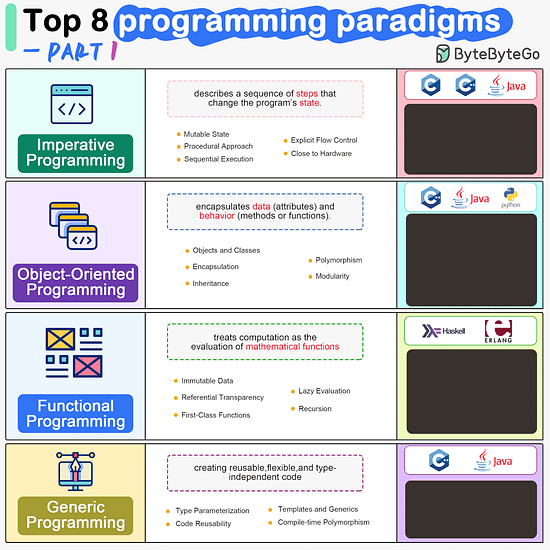
ByteByteGo | Newsletter/Blog
From the newsletter:
Imperative Programming Imperative programming describes a sequence of steps that change the program’s state. Languages like C, C++, Java, Python (to an extent), and many others support imperative programming styles.
Declarative Programming Declarative programming emphasizes expressing logic and functionalities without describing the control flow explicitly. Functional programming is a popular form of declarative programming.
Object-Oriented Programming (OOP) Object-oriented programming (OOP) revolves around the concept of objects, which encapsulate data (attributes) and behavior (methods or functions). Common object-oriented programming languages include Java, C++, Python, Ruby, and C#.
Aspect-Oriented Programming (AOP) Aspect-oriented programming (AOP) aims to modularize concerns that cut across multiple parts of a software system. AspectJ is one of the most well-known AOP frameworks that extends Java with AOP capabilities.
Functional Programming Functional Programming (FP) treats computation as the evaluation of mathematical functions and emphasizes the use of immutable data and declarative expressions. Languages like Haskell, Lisp, Erlang, and some features in languages like JavaScript, Python, and Scala support functional programming paradigms.
Reactive Programming Reactive Programming deals with asynchronous data streams and the propagation of changes. Event-driven applications, and streaming data processing applications benefit from reactive programming.
Generic Programming Generic Programming aims at creating reusable, flexible, and type-independent code by allowing algorithms and data structures to be written without specifying the types they will operate on. Generic programming is extensively used in libraries and frameworks to create data structures like lists, stacks, queues, and algorithms like sorting, searching.
Concurrent Programming Concurrent Programming deals with the execution of multiple tasks or processes simultaneously, improving performance and resource utilization. Concurrent programming is utilized in various applications, including multi-threaded servers, parallel processing, concurrent web servers, and high-performance computing.
#bytebytego#resource#programming#concurrent#generic#reactive#funtional#aspect#oriented#aop#fp#object#oop#declarative#imperative
8 notes
·
View notes
Text
How Python Works in Real-Time Scenarios
1. Real-Time Web Applications with FastAPI, Django, or Flask + WebSockets
Python frameworks such as FastAPI and Django Channels support real-time communication using WebSockets.
Example: A customer support chat system where Python handles incoming messages, broadcasts them to agents, and stores them instantly in the database.
How it works:
WebSockets create a persistent two-way connection.
Async programming (with async/await) allows high-concurrency handling.
Python servers can push data instantly to connected clients.
2. Real-Time Data Processing with Celery and Redis
Python is excellent at background task execution using Celery, combined with Redis or RabbitMQ for message queuing.
Example: A stock trading app processes thousands of price updates per second and triggers alerts based on real-time changes.
Why Python fits:
Asynchronous task queues
Scheduled jobs and retries
Lightweight and fast messaging systems
3. IoT Applications and Sensor Data Processing
Python is a popular language for IoT development, especially using Raspberry Pi or microcontrollers with MicroPython.
Example: A smart farming solution collects sensor data (temperature, humidity, moisture) and notifies farmers in real time via mobile.
Real-time flow:
Python collects data via GPIO
Sends data to cloud or edge devices via MQTT/HTTP
Dashboards built using Dash or Flask update instantly
4. Machine Learning and AI in Real-Time
With libraries like TensorFlow, PyTorch, and scikit-learn, Python powers intelligent apps that respond in real time.
Example: A face detection system used in surveillance cameras that identifies and tracks people in live video feeds.
Real-time implementation:
Python handles video stream frame-by-frame
ML model inference happens in milliseconds
Results pushed to UI using Flask or FastAPI
5. Mobile and Desktop Integration with Python
Python frameworks like Kivy and PyQt allow developers to build responsive desktop or mobile apps that handle live data.
Example: A logistics company dashboard showing live truck movement and delivery status.
Why Python is used:
Easy UI updates using signals/slots
Integration with GPS and APIs
SQLite or PostgreSQL used for real-time data storage
🔒 Security and Performance in Real-Time Python Apps
Although Python is interpreted and may be slower than compiled languages like C#, it still supports:
JWT-based Authentication
Data encryption using cryptography libraries
Asynchronous I/O with asyncio, aiohttp, and trio
Performance tuning via Cython, Numba, and multiprocessing
🎯 Why Use Python for Real-Time Applications?
Feature
Benefit
Asynchronous I/O
Manage multiple connections without blocking
Fast Development
Rapid prototyping and deployment
Rich Ecosystem
Libraries for every real-time use case
Platform Flexibility
From IoT to AI to web—Python runs everywhere
Scalable Infrastructure
Works well with Docker, Kubernetes, and cloud services
🏁 Conclusion
Python is not just a scripting language—it’s a real-time powerhouse. Whether it’s chat systems, IoT dashboards, real-time analytics, or AI applications, Python proves its value with scalability, simplicity, and community support.
At Monopoly IT Solutions, the best software training institute in Hyderabad, we offer hands-on training in Python for both real-time and enterprise-grade applications. With project-based learning and expert mentorship, you’ll gain the skills needed to build real-time apps using Python for today's job market.
0 notes
Text
Must-have for slacking off! 2025 Efficient Dev Tools for Increasing Productivity
Being a programmer is challenging with the constant flow of code and demands. Balancing work and relaxation is a tough task, but there are powerful tools to ease the workload. "The right tools for the job" – This article aims to help you discover some handy tools.
DevDocs - Your Offline Documentation Companion
DevDocs , an offline API documentation browser, supports multilingual, offering developers a quick and efficient way to access tech docs. From front-end to back-end and mobile development, it integrates official documentation, providing a sleek, user-friendly interface.
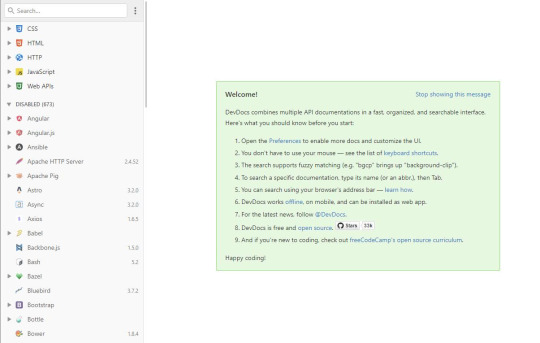
ServBay - A Developer's Dream
ServBay is hailed as a must-have tool for web developers, providing an instant, all-in-one web development environment. It eliminates the hassle of setting up Python, Java, Golang, PHP, Nodejs, Redis, and databases, allowing developers to focus on coding. It includes a range of commonly used web development service software and tools, covering web servers, databases, programming languages, mail servers, queue services, etc., aiming to provide developers with a convenient, efficient, and unified dev environment.
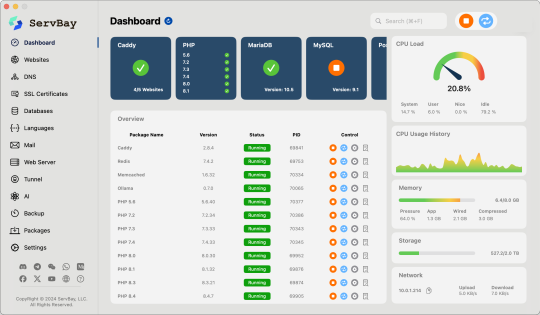
Meta Tags Toolkit - SEO Simplified
Meta Tags Toolkit is a tool to help you generate and manage metadata, making your website more search engine-friendly. It can be used to create and optimize meta tags for websites. Meta tags are the metadata of web pages used to describe the content, theme, and attributes of a webpage. Needless to say, everyone knows how important search engine optimization (SEO) is for website access and promotion.
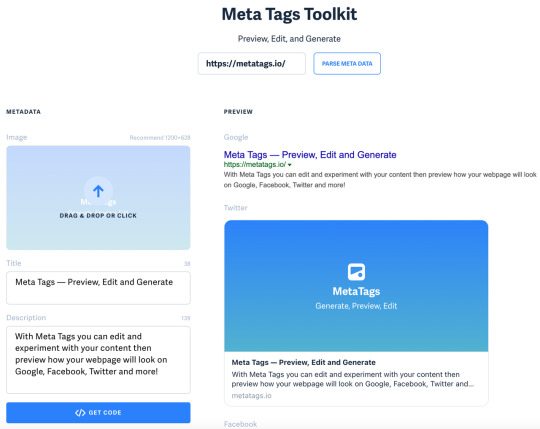
Regulex - Visualize Regular Expressions
Regulex , an online regex testing tool, helps developers intuitively test and debug regular expressions. Its graphical display illustrates the matching process and structure.
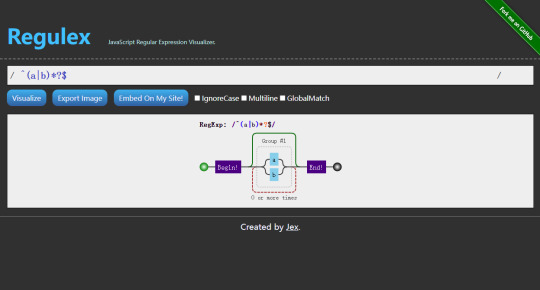
Carbon - Beautify Your Code Online
Carbon , an online code beautification tool, lets you create visually appealing code screenshots with a simple interface, enhancing code readability.
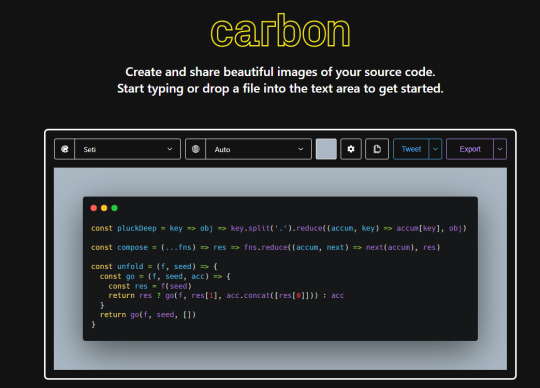
Github Copilot - Your AI Coding Assistant
Github Copilot is one of the best AI code assistants on the market to date. It aims to help developers write high-quality code more efficiently, powered by the OpenAI Codex language model, trained on natural language text and insights from a vast amount of public code. This intelligent tool can suggest entire lines of code, complete functions, write comments, and even help with debugging and identifying potential security issues.

Paste - Streamlined Content Sharing
Paste is a straightforward and effective pasting tool, prioritizing a minimalist user experience. Supporting syntax highlighting for various languages, it facilitates easy sharing of code, text, and other content, enhancing readability and professionalism.

In Conclusion
Taking short breaks can be the spice of professional life. I encourage everyone to organize work time sensibly, prioritize communication and work skills, and leverage powerful tools to ensure the completion of work with both quality and quantity. Like giving wings to a tiger, find the work style that suits you best.
#python#programming#web development#coding#100 days of productivity#productivitytools#productivitytips#time management
1 note
·
View note
Text
CodeRabbit GitHub builts AI code review agent with Cloud Run

CodeRabbit GitHub
CodeRabbit, a fast-growing AI code review platform, uses Google Cloud execute to safely execute untrusted code and cut code review time and mistakes in half.
CodeRabbit automates code reviews and improves code quality by comparing changes to the whole codebase and creating scripts for deeper analysis. Code hosting integration handles pull requests automatically.
To securely execute untrusted code, CodeRabbit needed a scalable, inexpensive, and secure execution environment to evaluate and run its clients' code.
You'll see how CodeRabbit utilised Google Cloud Run to construct an AI code review agent that can scale dynamically and safely manage massive amounts.
CodeRabbit integrates directly to GitHub and GitLab to automate pull request-triggered code reviews. Its interface with fundamental models analyses the whole change's impact, not just the updated files. This requires a sophisticated system that:
Clone the user's repository.
Install build environment requirements (npm install, go mod download, etc.).
Static analysis with 20+ linters and security scanners.
Run AI programs. Now things get really interesting. CodeRabbit's AI agent develops shell scripts to read the code, find patterns (using cat, grep, and ast-grep), and extract relevant information. Python code can be generated for analysis.
Use outside services. CodeRabbit generates and runs curl instructions to interact with Slack, Jira, and Linear.
Any solution must be safe, inexpensive, and scalable. By definition, analysed and run code is unreliable. It may have problems, be incomplete, or be dangerous.
The answer: Cloud Run
CodeRabbit seamlessly integrates many technologies to create a reliable and isolated execution environment:
Cloud Run services underpin CodeRabbit. First, a lightweight Cloud Run service validates subscriptions and invoicing and handles GitHub, GitLab, etc. webhook events. This service pushes a task to Google Cloud Tasks.
Google Cloud tasks: Serving as a queue isolates webhook handling from code execution. CodeRabbit now handles pull request surges without overloading.
The core of the system is Cloud Run execution service. Another Cloud Run service pulls tasks from Cloud Tasks. Every job requests code review. A 3600-second request timeout and 8 requests per instance allow this service to grow with CPU use. This setup is necessary since code reviews take 10–20 minutes. The Execution Service's in-memory volume mount holds the repository, build artefacts, and temporary files.
Sandboxing: A separate service identity lets you give all Cloud Run instances minimum IAM privileges. Both sandboxing levels are applied to all instances. CodeRabbit employs Cloud Run's second-generation Linux cgroup-capable microVM. CodeRabbit uses cgroups to restrict jailed processes and Jailkit to isolate processes within Cloud Run instances.
CodeRabbit prioritises sandboxing while running untrusted code, such as:
Rubocop and ESLint accept unique, unstable plugins.
LLM verification programs for codebase-wide analysis.
LLM CLI tasks like Jira or GitHub problem creation.
Python-based advanced analysis.
CodeRabbit scales dynamically using Cloud Run. During peak hours, over 200 Cloud Run computers submit 10 queries per second to CodeRabbit's Agentic PR Reviewer. Each big Cloud Run instance utilises 32GiB RAM and 8vCPUs. CodeRabbit's PR reviewer service on Cloud Run uses a lot of CPU, memory, and network traffic (downloading repositories and dependencies).
Try it yourself
CodeRabbit's use of Google Cloud Run shows how to build a secure, scalable, and affordable AI-powered code analysis platform. Their experience shows serverless technologies' promise, and their design can help developers solve similar difficulties. Cloud Run constantly adding features.
#technology#technews#govindhtech#news#technologynews#CodeRabbit GitHub#CodeRabbit#GitHub#Google Cloud Run#CodeRabbit AI#AI code review agent
0 notes
Text
Understanding Microservices - A Comprehensive Guide for Beginners

In recent years, microservices have become a popular way to build software, changing how apps are built and handled. The microservices concept fundamentally involves separating a software program into smaller, self-contained pieces, each concentrated on a certain business function. This modularity sets microservices apart from conventional monolithic designs, which firmly marry all elements. Microservices provide a more flexible and scalable approach to creating applications that change with the times by working autonomously.
One of the primary benefits of microservices is the ability to scale individual services based on demand. Instead of scaling the entire application, as necessary in a monolithic system, you can scale specific microservices experiencing high traffic. This selective scalability leads to more efficient resource utilization, ensuring that only the required components consume additional computational power. As a result, you achieve better performance and cost savings in operational environments, particularly in cloud-based systems.
Another hallmark of microservices is their support for technological diversity. Unlike monolithic architectures that often impose a uniform set of tools and languages, microservices empower developers to choose the most appropriate technologies for each service. For instance, developers might write one service in Python while using Java for another, depending on which language best suits the tasks. This approach not only boosts the efficiency of each service but also encourages innovation, as teams are free to experiment with new frameworks and tools tailored to their needs.
The independence of microservices also enhances fault tolerance within applications. Since each service operates in isolation, a failure in one part of the system does not necessarily cascade to others. For example, if a payment processing service goes offline, other application parts, such as user authentication or browsing, can continue functioning. This isolation minimizes downtime and simplifies identifying and resolving issues, contributing to system reliability.
Microservices naturally align with modern agile development practices. In a microservices architecture, development teams can work simultaneously on different services without interfering with one another. This concurrent workflow accelerates the development lifecycle, enabling faster iteration and deployment cycles. Moreover, microservices support continuous integration and delivery (CI/CD), further streamlining updates and allowing teams to respond more quickly to user feedback or market changes.
However, microservices are not without challenges. Communication between services often becomes complex, as each service needs to interact with others to perform end-to-end business processes. This necessitates robust communication protocols, often using APIs or message queues. Ensuring data consistency across services is another critical concern, particularly when each service maintains its database. Strategies such as eventual consistency and distributed transactions are sometimes employed, but these solutions can add complexity to the system design.
The advent of containerization technologies, such as Docker and Kubernetes, has made implementing microservices more accessible. Containers provide a lightweight and consistent environment for deploying individual services, regardless of the underlying infrastructure. With cloud platforms like AWS, Azure, or Google Cloud, organizations can leverage these tools to build scalable and resilient applications. This synergy between microservices and modern infrastructure tools has driven their adoption across industries.
Despite their advantages, microservices may not always be the optimal choice. For smaller applications with limited complexity, the overhead of managing multiple independent services can become burdensome. Monolithic architectures may serve as a more straightforward and more cost-effective solution in such cases. Evaluating your application's specific needs and long-term goals is essential before committing to a microservices-based approach.
0 notes
Text

"Top 5 High-Demand Python Careers to Pursue in 2025" 🚀
Python continues to be a dominant programming language in 2025, powering AI, data science, cybersecurity, cloud computing, and web development. Here’s a detailed look at the top Python-related careers:
1️⃣ AI & Machine Learning Engineer 🤖
Why It’s Trending:
AI and Machine Learning are revolutionizing industries like healthcare, finance, and automation. Python is the primary language for developing AI applications, thanks to its vast ecosystem of ML libraries.
Key Python Skills & Tools:
✅ TensorFlow, Py Torch, Scikit-learn – Machine learning & deep learning models ✅ OpenCV, NLTK, Spa Cy – Computer vision & NLP applications ✅ Pandas, NumPy, Matplotlib – Data processing & visualization ✅ Flask/Fast API – Deploying AI models as web services
Career Opportunities:
🔹 AI Researcher 🔹 Machine Learning Engineer 🔹 NLP Engineer 🔹 Computer Vision Developer
2️⃣ Data Scientist 📊
Why It’s Trending:
With businesses relying on data-driven decision-making, data scientists are in high demand. Python is the go-to language for data analysis, big data, and predictive analytics.
Key Python Skills & Tools:
✅ Pandas, NumPy, SciPy – Data manipulation & scientific computing ✅ Matplotlib, Seaborn, Plotly – Data visualization ✅ Scikit-learn, XGBoost – Predictive modeling ✅ SQL & Big Query – Working with databases ✅ Apache Spark – Big data processing
Career Opportunities:
🔹 Data Analyst 🔹 Business Intelligence Analyst 🔹 Data Engineer 🔹 Data Scientist
3️⃣ Cybersecurity Analyst 🔐
Why It’s Trending:
As cyber threats increase, Python is widely used in cybersecurity for automating security tests, penetration testing, and threat detection.
Key Python Skills & Tools:
✅ Requests, Beautiful Soup – Web scraping for security audits ✅ Scapy, Py Shark – Network security & packet analysis ✅ Py Crypto, Cryptography – Encryption & decryption techniques ✅ TensorFlow (AI for Cybersecurity) – AI-based threat detection ✅ Selenium – Automating security testing
Career Opportunities:
🔹 Ethical Hacker 🔹 Security Engineer 🔹 SOC Analyst 🔹 Digital Forensics Expert
4️⃣ Cloud & DevOps Engineer ☁️
Why It’s Trending:
With businesses migrating to the cloud, Python is essential for cloud automation, DevOps, and infrastructure management.
Key Python Skills & Tools:
✅ AWS, Azure, Google Cloud SDKs – Cloud services integration ✅ Terraform & Ansible – Infrastructure as Code (IaC) ✅ Docker & Kubernetes – Containerization & orchestration ✅ CI/CD (Jenkins, GitHub Actions) – Automating deployments ✅ Boto3 – AWS automation
Career Opportunities:
🔹 Cloud Engineer 🔹 DevOps Engineer 🔹 Site Reliability Engineer (SRE) 🔹 Cloud Security Engineer
5️⃣ Full-Stack Developer 💻
Why It’s Trending:
Python frameworks like Django and Flask power high-performance web applications. With AI integration becoming common in web apps, Python developers are in demand.
Key Python Skills & Tools:
✅ Django & Flask – Backend development ✅ Fast API – High-performance APIs ✅ React, Angular, Vue.js – Frontend frameworks ✅ PostgreSQL, MongoDB – Databases ✅ Celery, RabbitMQ – Task queues for scaling apps
Career Opportunities:
🔹 Full-Stack Developer 🔹 Backend Developer 🔹 API Developer 🔹 Web Application Engineer
Final Thoughts: Why Choose Python in 2025? 🚀
✔ Easy to Learn – Beginner-friendly with a simple syntax ✔ Highly Versatile – Used in AI, Data Science, Web Dev, and more ✔ Strong Community & Libraries – Open-source support for innovation ✔ High-Paying Jobs – Python careers offer some of the best salaries in tech
💡 Upskill in Python today and secure a future-proof career in 2025! 🚀
For Python Compiler Visit-https://www.tpointtech.com/compiler/python
1 note
·
View note
Text
免费蜘蛛池程序源码解析
在互联网技术领域,爬虫技术是获取信息的重要手段之一。而“蜘蛛池”则是指一种用于管理和调度爬虫任务的系统。今天,我们将深入解析一款免费的蜘蛛池程序源码,帮助大家更好地理解和使用这一工具。
1. 蜘蛛池的基本概念
蜘蛛池(Spider Pool)是一种集中管理多个爬虫任务的系统。它能够高效地分配和调度爬虫任务,提高数据抓取的效率。通过将多个爬虫任务统一管理,可以避免资源浪费,同时也能更好地应对目标网站的反爬策略。
2. 源码解析
我们选择了一款开源且免费的蜘蛛池程序进行分析。这款程序主要由以下几个部分组成:
任务管理模块:负责接收新的爬虫任务,并将其加入到任务队列中。
调度模块:根据一定的规则从任务队列中取出任务,并分配给相应的爬虫执行。
爬虫模块:具体执行爬虫任务,抓取网页数据。
日志记录模块:记录爬虫任务的执行情况,包括成功、失败等信息。
3. 核心代码分析
下面是一段核心代码示例,展示了如何实现任务调度:
```python
class Scheduler:
def __init__(self):
self.task_queue = Queue()
def add_task(self, task):
将任务添加到队列中
self.task_queue.put(task)
def run(self):
while True:
if not self.task_queue.empty():
task = self.task_queue.get()
分配任务给爬虫执行
spider = Spider()
spider.run(task)
```
这段代码定义了一个`Scheduler`类,用于管理任务队列并调度任务。`add_task`方法用于向队列中添加新任务,而`run`方法则不断从队列中取出任务并分配给爬虫执行。
4. 使用场景与注意事项
蜘蛛池程序广泛应用于数据采集、市场调研等领域。但在使用时需要注意以下几点:
合法性:确保你的爬虫行为符合相关法律法规,尊重目标网站的robots.txt文件。
性能优化:合理设置并发数,避免对目标网站造成过大压力。
错误处理:完善错误处理机制,确保程序的稳定性和可靠性。
结语
通过上述解析,相信大家对蜘蛛池程序有了更深入的理解。如果你有任何疑问或想要进一步探讨的话题,请在评论区留言。期待与你一起交流!
希望这篇文章能帮助你更好地理解蜘蛛池程序的工作原理及其应用。
加飞机@yuantou2048

SEO优化
币圈推广
0 notes
Text
Price: [price_with_discount] (as of [price_update_date] - Details) [ad_1] Master efficient parallel programming to build powerful applications using PythonKey FeaturesDesign and implement efficient parallel softwareMaster new programming techniques to address and solve complex programming problemsExplore the world of parallel programming with this book, which is a go-to resource for different kinds of parallel computing tasks in Python, using examples and topics covered in great depthBook DescriptionThis book will teach you parallel programming techniques using examples in Python and will help you explore the many ways in which you can write code that allows more than one process to happen at once. Starting with introducing you to the world of parallel computing, it moves on to cover the fundamentals in Python. This is followed by exploring the thread-based parallelism model using the Python threading module by synchronizing threads and using locks, mutex, semaphores queues, GIL, and the thread pool.Next you will be taught about process-based parallelism where you will synchronize processes using message passing along with learning about the performance of MPI Python Modules. You will then go on to learn the asynchronous parallel programming model using the Python asyncio module along with handling exceptions. Moving on, you will discover distributed computing with Python, and learn how to install a broker, use Celery Python Module, and create a worker.You will understand anche Pycsp, the Scoop framework, and disk modules in Python. Further on, you will learnGPU programming withPython using the PyCUDA module along with evaluating performance limitations.What you will learnSynchronize multiple threads and processes to manage parallel tasksImplement message passing communication between processes to build parallel applicationsProgram your own GPU cards to address complex problemsManage computing entities to execute distributed computational tasksWrite efficient programs by adopting the event-driven programming modelExplore the cloud technology with DJango and Google App EngineApply parallel programming techniques that can lead to performance improvementsWho this book is forPython Parallel Programming Cookbook is intended for software developers who are well versed with Python and want to use parallel programming techniques to write powerful and efficient code. This book will help you master the basics and the advanced of parallel computing. Publisher : Packt Pub Ltd (29 August 2015) Language : English Paperback : 286 pages ISBN-10 : 1785289586 ISBN-13 : 978-1785289583 Item Weight : 500 g Dimensions : 23.5 x 19.1 x 1.53 cm Country of Origin : India [ad_2]
0 notes
Text
Tips for Cracking Your First Job Interview as a Developer
Getting your first job as a developer can be both exciting and nerve-wracking. "Tips for Cracking Your First Job Interview as a Developer" are invaluable to help you navigate the process with confidence. Whether you’re a fresher or someone transitioning into the tech industry, mastering the art of interviews is crucial for starting your career in programming.
How to Crack Technical Interview for Freshers
Freshers often find technical interviews intimidating, but preparation is the key to overcoming anxiety. Here's a step-by-step guide: 1. Research About the Company
Before walking into any interview, research the company thoroughly. Understand its mission, values, and recent projects. Tailor your responses to show how you align with the company’s goals and culture. Look up their tech stack and current openings to see how you can fit into their team. 2. Understand the Job Description
Carefully read the job description to identify the skills and tools the company is looking for. Make a checklist and match it with your own skills to prepare better. Highlight the technical and soft skills that align with the job role. Understanding the role’s key responsibilities helps you frame answers that showcase your strengths. 3. Understand the Basics of Coding and Programming
Companies want to see that you have a strong foundation in coding. Brush up on:
Data structures (e.g., arrays, linked lists, stacks, queues)
Algorithms (sorting, searching, recursion)
Problem-solving skills
Programming languages such as Python, Java, or C++
Object-oriented programming principles
4. Collect the Best Resources for Learning
Gather reliable resources like online tutorials, books, and platforms. For example:
"Cracking the Coding Interview" by Gayle Laakmann McDowell
Platforms like LeetCode, HackerRank, and Codewars
5. Work on Real-World Projects
Practical experience matters. Build projects like:
A personal portfolio website showcasing your skills.
A task management app with frontend, backend, and database integration.
Contributions to open-source projects on GitHub to build credibility.
6. Stay Updated on Industry Trends
Keep an eye on emerging technologies like cloud computing, AI, and blockchain. Understanding how these trends impact software development will set you apart from other candidates.
How to Clear Any Technical Interview
Clearing a technical interview is about more than just knowing how to code. You need to demonstrate your problem-solving approach, communication skills, and technical proficiency. 1. Do Mock Interviews
Participate in mock interview sessions with peers or mentors to simulate real-life scenarios. These sessions help you identify gaps in your knowledge and improve your communication. Use platforms like Pramp and Interviewing.io for structured mock interviews. 2. Work on Software Design Skills
If you’re aiming for roles like "Software Developer" or "Software Engineer," learn the basics of system design. Familiarize yourself with:
Design patterns (Singleton, Observer, Factory)
Database design principles
Microservices architecture
3. Write Clean Code
Employers value developers who write clean, maintainable code. Follow principles like
DRY (Don’t Repeat Yourself)
KISS (Keep It Simple, Stupid)
SOLID principles for object-oriented programming
Maintain proper code commenting and documentation 4. Test Your Code
Testing is critical in software development. Be prepared to explain how you would
Identify edge cases
Write unit tests using frameworks like JUnit or PyTest
Debug common issues effectively 5. Listen to Every Detail
Pay close attention to the questions and requirements provided during the interview. Sometimes, small details can make a significant difference in how you approach a problem. 6. Prepare for Behavioral Questions
Coding interviews aren’t just about technical skills. Be ready to answer questions like:
"Describe a time you faced a challenging project and how you handled it.
"How do you approach working with a team that has conflicting ideas?"
Use the STAR (Situation, Task, Action, Result) method to structure your responses.
Coding Interviews: Everything You Need to Prepare
If you're wondering how to approach coding interviews everything you need to prepare follow these actionable tips: 1. Practice Coding Questions
Spend time on platforms like LeetCode, HackerRank, and Codewars to get familiar with common "coding interview" questions. These questions often involve problem-solving under time constraints and test your logical thinking. 2. Try to Get Coding Certificates
Certification in programming languages or frameworks can enhance your resume. Look for certifications in Python, Java, or full-stack development with AI technologies such as NodeJS, DotNet Core, Angular, and ReactJS. 3. Good Communication Skills and Body Language
Your communication and body language can impact how interviewers perceive you. Maintain eye contact, speak clearly, and show enthusiasm for the role.
4. Self-Introduction and Formal Attire
Prepare a concise self-introduction highlighting your key skills and projects. Dress professionally to make a positive impression. 5. Stay Calm Under Pressure
Many interviews include challenging questions to test how you handle stress. Take a deep breath, think through your answer, and stay composed.
Company Interview Preparation
Preparing for specific companies can give you an edge. Each organization’s interview process varies, so tailor your strategy accordingly. 1. Optimize LinkedIn
Keep your LinkedIn profile updated. Connect with professionals from your target company to understand their culture and technical expectations. Post projects or achievements regularly to showcase your expertise. 2. Learn from Past Candidates
Look up company-specific interview questions on platforms like GeeksforGeeks or Glassdoor. Understanding the interview pattern and commonly asked questions can help you strategize better. 3. Freelancing as Practice
While learning, explore freelancing platforms like
Toptal
We Work Remotely
FlexJobs
Freelancing allows you to apply your skills in real-world scenarios and builds confidence.
Tips to Crack Your First Technical Interview
Your first technical interview is a significant milestone. Here are practical tips to ace it:
1. Speak Your Thoughts
When solving a problem, explain your thought process aloud. For example:
"First, I’d identify the constraints of the problem."
"Next, I’d choose the most efficient data structure to solve it." This approach showcases your problem-solving skills and logical thinking.
2. Leverage Online Resources
Use coding platforms and resources like:
Cracking the Coding Interview (book)
AlgoExpert (for algorithm prep)
Mock interviews on Pramp or Interviewing.io
3. Company-Specific Preparation
Research company’s tools and frameworks. Prepare accordingly to show how your skills align with their requirements.
4. Practice Real-Time Scenarios
Prepare for real-world scenarios where you may have to:
Debug an existing codebase
Build a feature from scratch
Optimize an algorithm for better performance
FAQs
What are the most common interview questions for developers?
Expect questions on data structures, algorithms, and coding problems. Behavioral questions like "Describe a challenging project" are also common. 2. Should I focus only on technical skills?
No, soft skills like communication and problem-solving are equally important. 3. How can I improve my coding skills?
Practice consistently on platforms like LeetCode and build real-world projects.
4. What tools should I learn as a Full Stack Developer?
Focus on tools like GitHub, Visual Studio Code, Node.js, ReactJS, MongoDB, and Docker to enhance your development skills.
5. How can I stand out during a technical interview?
Show a clear understanding of the problem
Communicate your solution effectively
Ask clarifying questions
Discuss alternative approaches if applicable
Conclusion
The article "Tips for Cracking Your First Job Interview as a Developer" provides actionable advice to help you prepare for and excel in coding interviews. These tips emphasize the importance of preparation, from mastering coding fundamentals to acing mock interviews and practicing system design. If you're ready to scale your career and become a skilled developer, consider enrolling in the "Full Stack Developer - MERN Stack Master's Program" at TechEntry. This program equips you with the skills and knowledge needed to excel in roles requiring expertise in Python, NodeJS, DotNet Core, Angular, and ReactJS. Got questions about "Tips for Cracking Your First Job Interview as a Developer" or our programs? Leave a comment below, and our experts will respond promptly. Start your journey to success with TechEntry today!
1 note
·
View note
Text
Flask and Celery: Building a Scalable Task Queue with Flask-Celery
Introduction Flask and Celery: Building a Scalable Task Queue with Flask-Celery is a powerful combination for building scalable web applications. Flask is a lightweight Python web framework that provides a flexible and modular way to build web applications, while Celery is a distributed task queue that allows you to run tasks asynchronously in the background. In this tutorial, we will explore…
0 notes